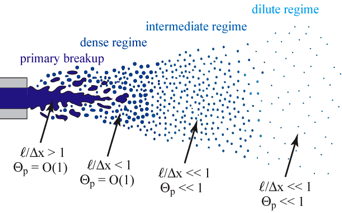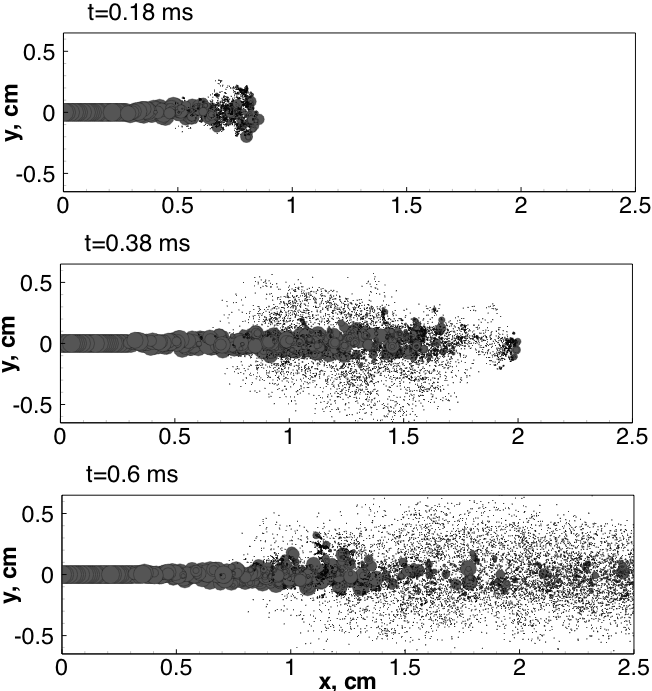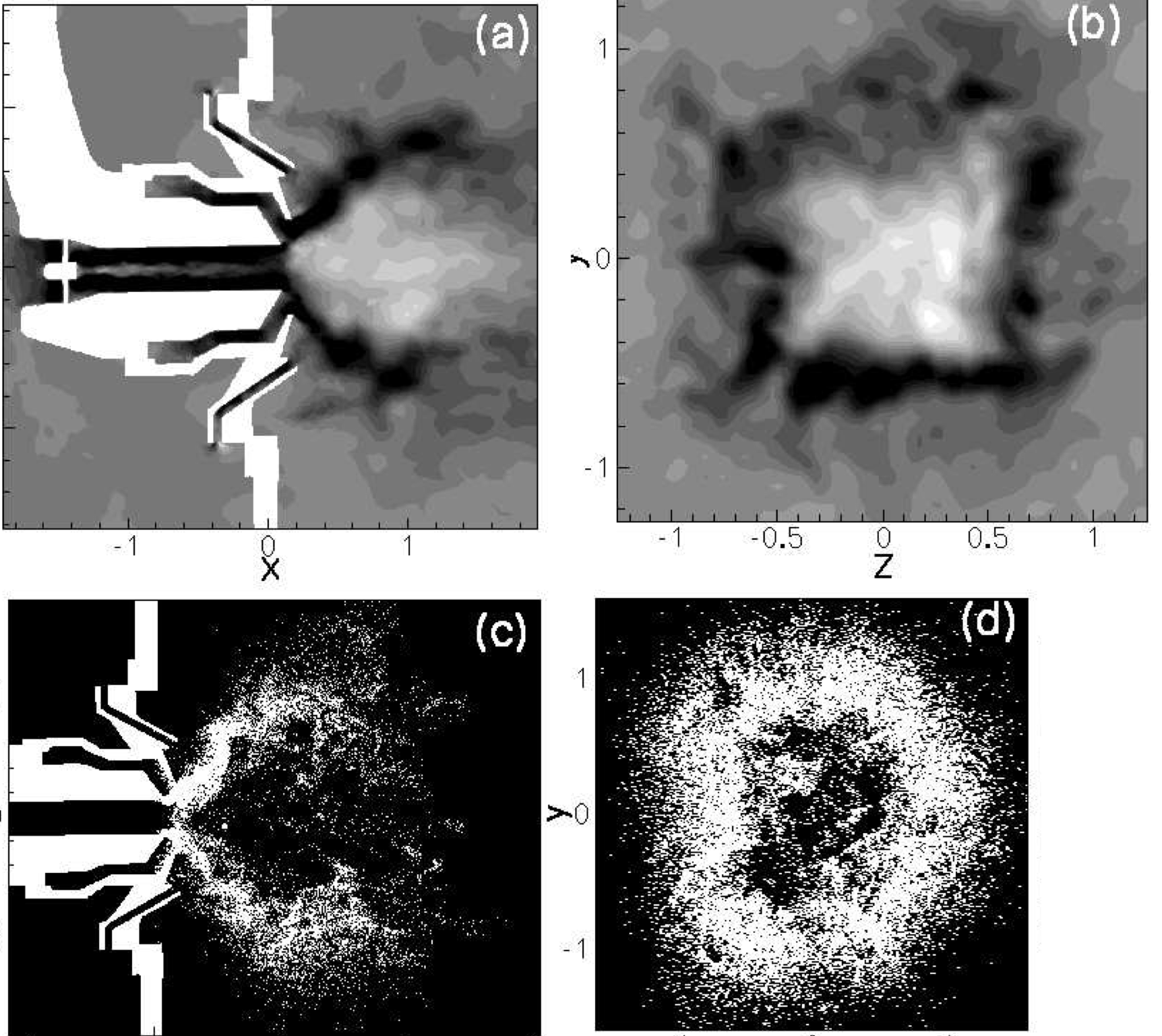|

Large Eddy Simulation of Sprays and Droplet-Laden Flows
Liquid spray and droplet dynamics play crucial roles in analyzing the combustion dynamics in many propulsion related applications. Majority of spray systems in propulsion applications involve complex geometries and highly unsteady, turbulent flows near the injector. The numerical models for spray calculations should be able to accurately represent droplet deformation, breakup, collision/coalescence, and turbulent dispersion. The broad range of time and length scales associated with primary and secondary breakup, evaporation, and mixing of fuel vapor with oxidizer, makes spray modeling a challenging task.
 Simulations involving comprehensive modeling of these phenomena from first principles (such as direct numerical simulation) are rare. Engineering prediction of such flows relies predominantly on turbulence models based on Reynolds-averaged Navier-Stokes equations (RANS). It has been shown that the predictive capability of large-eddy simulation (LES) is superior to RANS models. LES, although computationally expensive, captures the gas-phase flow physics accurately in swirling, separated flows commonly observed in combustion chambers of real propulsion systems. Simulations involving comprehensive modeling of these phenomena from first principles (such as direct numerical simulation) are rare. Engineering prediction of such flows relies predominantly on turbulence models based on Reynolds-averaged Navier-Stokes equations (RANS). It has been shown that the predictive capability of large-eddy simulation (LES) is superior to RANS models. LES, although computationally expensive, captures the gas-phase flow physics accurately in swirling, separated flows commonly observed in combustion chambers of real propulsion systems.
 In this work, we have developed a stochastic subgrid model to represent the atomization and droplet breakup process in turbulent flows with high Weber numbers. Here, the details of the ligament formation, liquid sheet/jet breakup in the near injector region are not computed in detail, but their global features are modeled in a statistical sense. Following Gorokhovski and Saveliev (Phy. Fluids 2005) atomization of liquid drops at high relative liquid-to-gas velocity is considered in the framework of uncorrelated breakup events, independent of the initial droplet size. Atomization is then modeled by a differential Fokker-Planck equation for the pdf of droplet radii. In this heuristic approach, atomization at high Weber numbers is viewed as a cascade process between large unstable drops down to small stable droplet sizes, analogous to Kolmogorv's view of an energy cascade mechanism in turbulence. We have applied this model to simulate high-speed jet sprays in a diesel engine as well as aerodynamic breakup in a gas-turbine combustor. In this work, we have developed a stochastic subgrid model to represent the atomization and droplet breakup process in turbulent flows with high Weber numbers. Here, the details of the ligament formation, liquid sheet/jet breakup in the near injector region are not computed in detail, but their global features are modeled in a statistical sense. Following Gorokhovski and Saveliev (Phy. Fluids 2005) atomization of liquid drops at high relative liquid-to-gas velocity is considered in the framework of uncorrelated breakup events, independent of the initial droplet size. Atomization is then modeled by a differential Fokker-Planck equation for the pdf of droplet radii. In this heuristic approach, atomization at high Weber numbers is viewed as a cascade process between large unstable drops down to small stable droplet sizes, analogous to Kolmogorv's view of an energy cascade mechanism in turbulence. We have applied this model to simulate high-speed jet sprays in a diesel engine as well as aerodynamic breakup in a gas-turbine combustor.
In an Eulerian-Lagrangian spray computation with models for atomization and breakup, large number of droplets are created very close to the injector causing load imbalance (droplets present only on few processors in a parallel computation). O'Rourke and Bracco (Proc. Mech. Eng. 1980) developed a parcels approach (parcel is a representative group of droplets with same droplet parameters). We have developed a hybrid droplet-parcel approach that represents spray evolution more accurately in a statistical sense and allows systematic reduction in the number of computational particles.
 We have also investigated droplet dispersion and evaporation models in the LES framework and applied these models to simulate spray breakup and evaporation in complex injectors. Recently, we have developed a numerical scheme that is stable and accounts for the volume displacement by the droplet motion and loading, especially in the dense spray regimes near the injector. It was shown in a simple test case of densely loaded particles in a Poisueille flow that this approach is important to capture the Kelvin-Helmholtz instability due to shearing motion between lighter and heavier fluids. We have also investigated droplet dispersion and evaporation models in the LES framework and applied these models to simulate spray breakup and evaporation in complex injectors. Recently, we have developed a numerical scheme that is stable and accounts for the volume displacement by the droplet motion and loading, especially in the dense spray regimes near the injector. It was shown in a simple test case of densely loaded particles in a Poisueille flow that this approach is important to capture the Kelvin-Helmholtz instability due to shearing motion between lighter and heavier fluids.
We are currently working on a stable and robust scheme for implicit coupling between the droplet and the continuum fluid, useful for high speed jet impingement on injector walls.
-
Apte S.V., Mahesh, K., and Moin, P. 2008, Large-eddy simulation of evaporating spray in a coaxial combustor, Proceedings of the Combustion Institute, Vol. 32., to appear Jan. 2009. (PDF)
-
Apte S.V., Mahesh, K., Gorokhovski, M., and Moin, P., 2008, Stochastic modeling of atomizing spray in a complex swirl injector using large-eddy simulation, Proceedings of the Combustion Institute, Vol. 32, to appear Jan 2009. (PDF)
-
Pozorski, J., and Apte, S. V., 2008, Filtered particle tracking and subgrid-scale dispersion modeling in two-phase turbulent flows, International Journal of Multiphase Flow, accepted. (PDF)
-
Shams, E., and Apte S.V., Modeling volumetric coupling in dispersed phase using Eulerian Lagrangian approach, ILASS America's 21st Annual Conference on Liquid Atomization and Spray Systems, Orlando, FL, May 2008. (PDF)
-
Apte S.V., Mahesh, K., and Lundgren, T. 2008, Accounting for finite-size effect in disperse two-phase flow, International Journal of Multiphase Flow, Vol. 34 (4), pp. 260-271. (PDF)
-
Kim, W.W., Apte, S.V., Herrmann, M., & Ham, F., 2004, Liquid film modeling in jet engine fuel injectors, Proceedings of the Summer Program, Center for Turbulence Research, Stanford University and NASA-AMES, pp. 305-314. (PDF)
-
Apte S. V., and Ghosal, S., 2004, A presumed PDF model for droplet evaporation / condensation in complex flows, Annual Research Briefs, Center for Turbulence Research, Stanford University and NASA-AMES, pp. 209-221. (PDF)
-
Apte, S. V., Gorokhovski, M., and Moin, P., 2003, LES of atomizing spray with stochastic modeling of spray break-up, International Journal of Multiphase Flows, Vol 29, pp. 1503-1522. (PDF)
|
|
|
| |
|
©All rights reserved by the Apte Research Group. |

